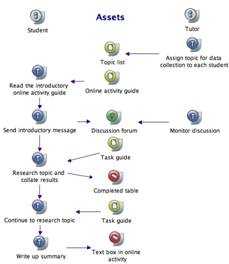A learning design methodology to foster and support creativity in design
DOI:
https://doi.org/10.54337/nlc.v6.9289Keywords:
Learning design, Methodology, Learning activities, CompendiumAbstract
This paper describes a project that is exploring the development and use of a learning design methodology. It summarises issues associated with trying to formalise and represent the design process which has emerged from our work to date, and relates this to similar findings in the literature. It describes work to date and in particular the iterative development of a prototype learning design system, CompendiumLD, to help designers/teachers create and share learning activities. Our goal is to build on recent research on learning design to develop a learning design methodology that provides support in the course design process with an emphasis on the use of technology-enhanced learning. This includes elicitation of current practice in design, identification of relevant resources and development of a prototype learning design tool. We believe it will be of interest and use to individual teachers and course teams, but also others involved in the design process tasked with helping course teams translate their ideas into technical solutions. We are adopting an iterative methodology focusing on two areas of activity in parallel: a) capturing and representing practice – through user consultation and case studies and b) supporting learning design – through the development of an online tool and associated workshops. Activities have included user consultation, collation of case studies of learning activities, interviews with teachers about the design process and in-depth evaluation of courses. A set of learning design resources and tools have been collated and a prototype learning design tool developed and trialled. We selected Compendium as the initial starting point for our learning design prototype, for a number of reasons: ease of use, flexibility, adaptability, supports the creation of a range of visual mapping techniques, and comes with a predefined set of icons. Figure one represents a screen shot of learning design in Compendium; two roles are shown, along with their respective tasks. Tools, resources and outputs (i.e. assets) associated with each task are shown alongside, with arrows indicating connections. Evaluation of initial versions of the tool suggested that it help users to articulate and share their design process. We are now in the second phase of the project. This includes further development of the tool to include contextual help and scaffolding. We are also undertaking a series of interviews with teachers about the design process, an in-depth evaluation of design across a course process and a series of user workshops and focus groups. Our work to date has given us a richer understanding of the design process and associated issue; however it is clear that there is a need for further research – practitioners are crying out for examples of good practice and guidance in design.

Figure one: Visual representation of part of a collaborative role play activity
Downloads
Published
How to Cite
Issue
Section
License
Copyright (c) 2008 Gráinne Conole, Andrew Brasher, Simon Cross, Martin Weller, Stewart Nixon, Paul Clark

This work is licensed under a Creative Commons Attribution-NonCommercial-NoDerivatives 4.0 International License.
CC BY-NC-ND
![]() This license enables reusers to copy and distribute the material in any medium or format in unadapted form only, for noncommercial purposes only, and only so long as attribution is given to the creator. CC BY-NC-ND includes the following elements:
This license enables reusers to copy and distribute the material in any medium or format in unadapted form only, for noncommercial purposes only, and only so long as attribution is given to the creator. CC BY-NC-ND includes the following elements:
BY: credit must be given to the creator.
NC: Only noncommercial uses of the work are permitted.
ND: No derivatives or adaptations of the work are permitted.
